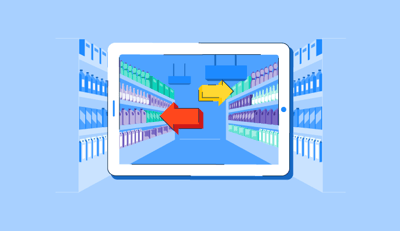July 19, 2018
 by Lauren Fram / July 19, 2018
by Lauren Fram / July 19, 2018
Online shopping is a big deal. You do it, I do it; we all love the convenience of clicking a button, typing a few keywords and having something show up at our doorstep a few days later.
Because sometimes it’s the middle of winter and you really don’t want to go outside to pick up lightbulbs; you can deal with that lamp not working for a few days.
With the increasing convenience and popularity of online shopping leading to more and more brands jumping on board, as well as the emergence of e-commerce software and an abundance of resources on how to make a website available for newbies to e-commerce, the online retail industry is booming. It's anticipated to grow to $4.5 trillion by 2021, up from $1.3 trillion in 2014. In 2017, Amazon reported $177.9 billion in revenue, making it the e-commerce leader in the U.S. (Note that Amazon reported $135.99 billion in 2016, showing significant growth in the past year.)
So, while Amazon is clearly killing it in the e-commerce space, one must note that Amazon also is branching out into the traditional brick-and-mortar retail space with the recent opening of the cashierless Amazon Go convenience store, the dozen or so Amazon Books storefronts and the recent acquisition of Whole Foods.
Meanwhile, traditional retail spaces are not going anywhere, despite the fact that online retail growth is outpacing traditional retail growth 10 to 1. No need to despair, though; retail stores won’t be torn down anytime soon, they’re just going to become a lot more high-tech.
In fact, during the 2017 holiday season, 42 percent of shopping was done in retail stores with 51 percent done online. That isn’t a large gap at all, and with online companies adding storefronts, that gap may close even more in the future.
Certain items are best bought in person, and as much as technology seeks to replicate the experience, there’s little augmented reality software can do to convince me those jeans will fit without trying them on first. For large purchases especially, many people feel much more comfortable making an in-person decision.
There’s also the issue of unreliable color representation on various screens, making it difficult to determine if those pillows will, in fact, match your sofa perfectly or if the lighting of the photograph or the color saturation of your computer screen just makes it look like they will.
So, while online shopping is definitely the wave of the future, here are some retail technology trends that are changing the face of brick-and-mortar shopping:
Artificial intelligence and machine learning software are becoming more and more prevalent in all kinds of software, and there are myriad benefits to reap from using them. When it comes to retail, there are several uses for artificial intelligence that can give any store a leg up.
Chatbots, for instance, are a widely used AI technology that helps businesses by freeing up customer service reps to spend more time on more complicated requests with the potential to win back customers. Retail robots such as SoftBank’s Pepper, a humanoid robot on wheels meant to answer simple customer questions and give directions, can provide a similar service in brick-and-mortar stores. Researchers found that Pepper’s presence increased foot traffic by 20 percent and revenue by 300 percent, demonstrating that there is a real-life use for these shop assistant robots.
Machine learning also can be applied to all the customer data gathered by retailers, creating buyer profiles and more personalized shopping experiences. Many stores are often designed using this data, placing items that are commonly purchased together near each other or popular items near eye level. One example is the Amazon Books storefronts, which are designed using an algorithm.
Much like the Amazon website will suggest items based on the products you’ve clicked on, Amazon Books groups books together that are commonly viewed or purchased at the same time. Some are critical of this method, claiming it ruins the experience of visiting a bookstore by preventing the possibility of stumbling across something you would never pick out on your own.
AI is also beginning to take over manual tasks typically done by employees. Walmart, for instance, is implementing shelf-scanning robots that can determine when inventory needs to be replenished, if there are any misplaced items and any pricing mistakes. While the fear is that AI will take over human employees’ jobs, in reality, the goal is to make human employees’ jobs easier while creating a better experience for customers.
Augmented reality and virtual reality are gaining traction in many markets, but the most practical implementation seems to be in retail. From virtually touring homes and apartments to virtually placing furniture in your space, AR and VR are becoming more and more widely used across the retail industry because of their ability to help visualize experiences that can be crucial to making a purchasing decision but difficult to achieve without buying the product first.
Some retailers are using AR in stores to improve the customer experience by providing additional information about products such as reviews or color and sizing availability. Some clothing stores are creating virtual fitting rooms that use cameras to display customers wearing items of clothing in the store. AR also can bring the shopping experience into homes, allowing customers to see products in their personal spaces without the commitment.
Virtual reality has several practical applications in retail other than creating unique brand experiences. Some stores use VR to draw in customers with the promise of a unique experience, such as a VR slide down the side of a building. VR can also be used with heat map technology to better organize stores and see what customers gravitate toward.
Personalized online shopping experiences have been standard for some time now, but there are more efforts being made to personalize the in-person experience as well. Tools such as CRM software and marketing automation software platforms are helping this become a reality, but much of the heavy lifting is being done by machine learning.
Bridging the gap between the online and physical experiences is a major focus of many brands, leading to the “showroom model” where customers can browse products in person, speak to sales associates and test products. However, once a purchase is made, the product is then shipped from another location, providing an experience similar to online shopping.
Smart stores such as these are popping up more and more, but many retailers also offer options such as online purchasing with the ability for in-store pickup. Giving customers alternatives to the traditional retail experience provides a variety of ways to interact with the brand, making it more accessible for a wider array of buyers.
By closing the gap between the online and in-person experiences while making it easier than ever before to stay in touch with customers, retailers are merging the tech space and reality to create a seamless experience.
With the popularity of virtual assistants such as Amazon’s Alexa and Google Home, retail companies are working to take advantage of the ability to make a purchase simply by asking. This, however, is no easy feat. Companies must work with voice recognition software technologies as well as natural language processing to make these interactions as seamless and mistake-free as possible.
Since AI and machine learning are expected to play a large role in retail because of their ability to automate manual tasks and find trends within huge amounts of data, integrating with virtual assistants is a logical progression. With 45 million voice assistants installed in homes around the world as of 2017, that’s a lot of potential business.
However, companies will need to work with Amazon, Google and others to broker deals for access to these voice assistants. Customers already enjoy the convenience of placing orders from their homes; placing orders verbally will remove several steps from the process. But companies must ensure these orders are reliable and safe, and that parrots can’t place multiple orders for berries.
Omnichannel marketing in retail is an approach that provides a universal experience across all possible channels: online, mobile, in-person, etc. By interacting with any one branch of a business, the customer is interacting with all other branches, creating an ideal experience that customers enjoy.
Theoretically, customers can buy online and pick up in store, buy in store and return online, buy online and return in store or buy in store and have the item delivered. The various combinations can be used to fit a wide variety of customer needs, making the brand more accessible and accommodating.
Loyalty programs, targeted email marketing, user-specific landing pages and special in-store discounts for online shoppers are all aspects of omnichannel retail. While these sound easy to implement, the reality is that these are complex systems requiring a lot of time and data to implement that need to coordinate with each other to create a unified experience. And though the implementation may be difficult, the end goal is worth it and representative of the future of retail.
Retail is far from dead, and innovations within the space are occurring all the time. With the application of systems such as AI and other complex technologies, there’s no telling what kinds of interesting retail experiences will emerge. The key is to be flexible and embrace retail technology as a tool in the increasingly digital toolbox.
Ready to learn more about the future of selling? Learn how to sell on Facebook Shop in 2018.
Lauren is a former market research analyst focusing on the e-commerce and retail industries. Since joining G2 in July 2017, she has focused her energy on consumer-driven spaces after spending time in the vertical, design, and CAD software spheres. She graduated from the University of Chicago with a degree in English language and literature and her writing and research has been cited in publications such as Forbes, Eater, and Nasdaq.com, among others. She enjoys building and sharing her knowledge, and in her free time enjoys reading, knitting, and gaming. Her coverage areas include retail technology, e-commerce, and restaurant technology.
These days it seems like everything is done online.
 by Deirdre O'Donoghue
by Deirdre O'Donoghue
From fierce competition to evolving customer preferences, retailers have a lot to deal with.
 by Khuslen Khosbayar
by Khuslen Khosbayar
What will the future of retail look like?
These days it seems like everything is done online.
 by Deirdre O'Donoghue
by Deirdre O'Donoghue
From fierce competition to evolving customer preferences, retailers have a lot to deal with.
 by Khuslen Khosbayar
by Khuslen Khosbayar


